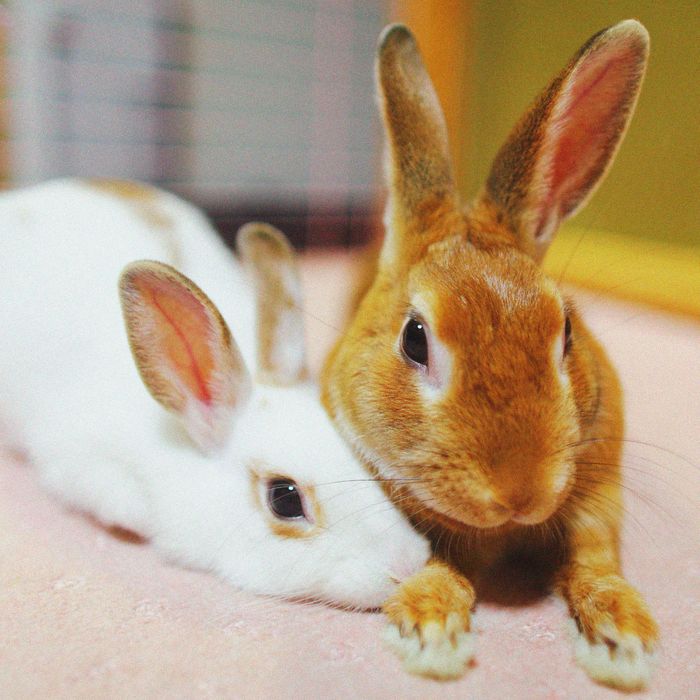
The deaths began on February 15: Ostensibly healthy bunnies plodding around per usual, eating normally, pooping regularly, and then the seizures started. “Someone saw them spasming and yelled,” recalled Lorelei D’Avolio, LVM, a certified veterinary practice manager with a veterinary-technician specialty in exotics at the Center for Avian and Exotic Medicine in Manhattan. “We tried to do CPR, but these rabbits were dead within minutes. They would convulse, scream horribly, and die.”
D’Avolio saw some of the bunnies go; others expired overnight, their delicate bodies offering no visible clues as to what killed them. “It was terrifying,” D’Avolio told the Cut. These were people’s pets, boarding together only temporarily, and it wasn’t until the fourth or fifth fatality that staff pinpointed a potential culprit: rabbit hemorrhagic disease virus type 2, a very rare calicivirus that had never been detected in New York City. “It wasn’t really on our radar,” D’Avolio said. “We knew what it was, but we didn’t think it could happen [here], because it had never happened before.”
The center stopped accepting new rabbit patients on February 19 and sent as many of their furry wards home as possible, quarantining the rest on-site. “The last rabbit, that we know of, died on February 29,” D’Avolio said. “We didn’t get the actual positive diagnosis until March 4.” Of 16 rabbits directly exposed to the virus, 14 died — baffling D’Avolio and her colleagues, who knew of no RHDV2 outbreaks in New York. And meanwhile, clear across the country, the New Mexico state veterinarian’s office began hearing about mass die-offs in wild cottontail and jackrabbit populations. Sudden, unexplained deaths in domestic bunnies followed shortly thereafter. Testing one of these rabbits confirmed it: RHDV2 had reached New Mexico.
“We still have no idea where it originated,” Ralph Zimmerman, New Mexico state veterinarian, told the Cut. “It’s snowballed and moved like mad,” fanning out across the Southwest. So far in 2020, the Animal and Plant Health Inspection Service at the U.S. Department of Agriculture says it has confirmed RHDV2 at 146 domestic premises and wildlife sites in Arizona, California, Colorado, Nevada, New Mexico, Utah, and Texas. Though the trajectory of the rabbit virus eerily mirrors that of our own pandemic, timelines are about the only common ground RHDV2 and the new coronavirus share. RHDV2 is “way more infectious than COVID,” D’Avolio warns. “It’s way more persistent, it’s resistant to extreme temperatures, it can be transmitted on bugs, on carcasses. It can spread on water, it can be spread on shoes.”
“We refer to it as ‘bunny ebola,’” Dr. Amanda Jones, a veterinarian based in Killeen, Texas, tells the Cut. She says she saw her first RHDV2 death in mid- to late April, shortly after the state’s first case cropped up in Hockley County, hundreds of miles away.
The first recorded outbreak of rabbit hemorrhagic disease, according to a report by the University of Iowa, occurred in China in 1984. This genotype may have traveled in on Angora rabbits imported from Europe and wound up killing an estimated 14 million domestic buns. The variation behind the current outbreak arrived in the U.S. only recently, showing up in Ohio in 2018 and then in Washington State in the summer of 2019. It may have originated in France around 2010 and has since established itself in Australia and Canada.
RHDV2 only affects rabbits, hares, and pikas, destroying cells in the liver and causing hepatitis. It also creates lesions on other organs — the heart, the lungs — that lead to internal bleeding, which in turn explains why some RHDV2-positive rabbits present with bloody fluid around their mouths and noses. It’s “not related in any way, shape, or form” to ebola, Jones stresses, but its effects on the body can look comparable: RHDV2 causes systemwide inflammation and, often, hemorrhaging. It moves swiftly and mercilessly once it invades a colony. Incubation takes between three and nine days, and the mortality rate ranges between 50 and 70 percent, according to the USDA. And it is wildly contagious: “We had one guy with 200 rabbits, and he lost them all between a Friday afternoon and Sunday evening,” Zimmerman said. “It just went through and killed everything.”
The first and only warning sign for RHDV2 infection often comes after the virus has already spread. Some rabbits with RHDV2 may seem a little sleepy once they get sick; some may lose interest in food. A diseased bunny could experience seizurelike convulsions, its lips peeling back from buck teeth in a morbid, leporine shriek. Typically, though, the sole symptom is sudden death — but even that’s not a certain sign. “Rabbits are notoriously fickle little creatures, and they tend to … die for no good reason,” Jones explains. “It’s really hard to tell between a rabbit that was sick [with RHDV2] and a rabbit that was sick with something else.” The only way to know for sure that your rabbit had it is to ship its carcass to the USDA’s Foreign Animal Disease Diagnostic Lab on Plum Island, New York, for posthumous testing.
RHDV2 does not affect people, cats, or dogs, but it does cling to clothes, shoes, and fur. A person or a pet can easily pick it up and bring it home, where the virus will — almost invariably, it seems — thrive. RHDV2 might live happily on surfaces for 3.5 months at room temperature and 225 days at 39 degrees Fahrenheit. It can survive both freezing and temperatures up to 122 degrees, at least for an hour. Only a handful of disinfectants, including bleach, can kill it. And it is potent. “Any contact with a sick rabbit can cause indoor rabbits … to get sick,” says Anne Martin, Ph.D., executive director of the House Rabbit Society. That contact might be as indirect as a fly landing on the body of an infected wild rabbit before buzzing into your house and clipping across a tabletop with its tiny contagion feet. If your bunny then comes thumping across that table, Martin cautions, “it could potentially die that way.”
Potentially, but not definitely, RHDV2’s widely variable death rate introduces yet another layer of chaos to the equation. RHDV2 kills many of its rabbit hosts, but those that survive, Zimmerman noted, “can shed from 30 days up to 105 days,” potentially passing on the virus. To avoid “constantly keeping a source available for exposure in that herd,” Zimmerman explained, New Mexico — and a number of its neighbors — instituted a depopulation policy: When one rabbit in a domestic nest comes down with the virus, the state vet’s office requires all of the rabbits to be euthanized. Between March and June, New Mexico has confirmed 492 domestic rabbit deaths from RHDV2, but when you factor in depopulation, the plague has claimed about 1,100 bunnies so far.
Luckily, a vaccine for RHDV2 does exist; unluckily, veterinarians must cut through a tangle of red tape to get it. RHDV2 qualifies as a foreign animal disease. As such, the U.S. has no licensed vaccine at the ready, requiring vets to import one of two formulas — Eravac from Spain or Filavac from France, both killed virus vaccines made from the livers of live rabbits — on the basis of “emergency need,” meaning once the virus has been confirmed in the state. But proving “emergency need” to the USDA is a long, arduous process that involves summiting a mountain of paperwork. Jones said she began seeking approval in early to mid-April and only received her order on June 9.
Her experience seems standard. Martin said her vaccine quest took 32 days. Zimmerman’s first order took five weeks to complete. D’Avolio says the Center for Avian and Exotic Medicine requested 500 vaccines as soon as it received positive test results, only to have its application and an appeal denied, allegedly because New York has no “active” problem in its domestic and wild rabbits. But given the rate at which RHDV2 balloons — and how it inherently catches officials flat-footed, unable to send for protection until after infection is underway — a six-week wait for a vaccine feels like a huge window to leave open to viral spread.
The USDA says a domestically produced, licensed vaccine could be ready by the end of the year; in the interim, the country must rely on the unlicensed, European imports, leaving rabbit owners with few options other than vigilance.
For now, Zimmerman says, biosecurity measures should remain top priority for rabbit owners, at least those in the Southwest: “Lock ’em down, keep ’em at home, keep people with rabbits away from your rabbits, make sure you’re keeping the wild rabbits away from your domestic rabbits.” That means screens on windows and doors, stringent hand scrubbing, removal of shoes and even outdoor clothes upon reentering a rabbit home, keeping in mind that D’Avolio and Zimmerman still don’t know exactly how RHDV2 arrived at their doorsteps, nor does Jones.
“I’m going to be really honest with you. I think there are more cases than have been reported,” Jones cautioned. “This isn’t just going to go away. This is a new problem that’s here to stay.”





